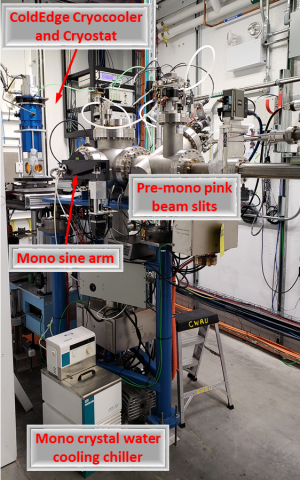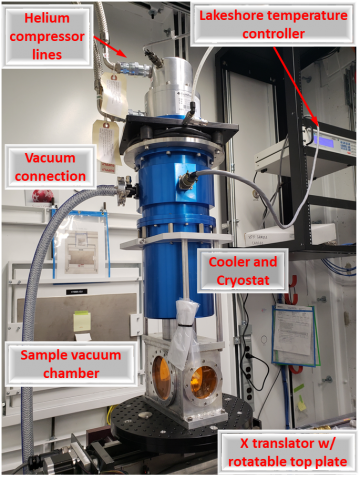The third endstation at XFP, located in the rear of the experimental hutch, provides access to monochromatic X-rays. It was initially developed to support a planned biological X-ray absorption spectroscopy capability on the beamline. The endstation is based around an optical chamber (repurposed from NSLS X6A, Figure 1) containing another set of pink beam slits and a channel-cut water-cooled Si(111) monochromator of the Siddons design. The monochromator (Figure 2) delivers 4.5 – 16 keV monochromatic X-rays to the sample, using a reduced horizontal source acceptance of 0.5 – 1 mrad defined by the XFP front-end slits. The endstation contains a motorized lift table outfitted with several independent stages for alignment of samples and apparatus into the beam. A helium Displex-type cryocooler from ColdEdge Technologies installed into a flexible vacuum cryostat for low-temperature biological XAS samples (Figure 3) is available for experiments.
Figure 1. Overview of optical components for the XFP monochromatic endstation. The pre-mono pink beam slits (repurposed from NSLS X6A) define beam size on the first crystal. A water-cooled (using a chiller) channel-cut Si(111) double crystal monochromator selects energy (4.5 – 16 keV) via a mono sine arm based motion. A cryostat with a ColdEdge cryocooler is available for low temperature experiments on a table with several motorized stages.
Figure 2. The channel-cut Si(111) crystal monochromator deflects beam upwards, with a 2nd crystal pico motor for detuning. Jacketed water cooling lines in vacuum transport cooling water to a block in thermal contact with the crystal. A motorized phosphor coated pink beam diagnostic absorber can image the beam and blocks any pink beam passing through the DCM.
Figure 3. A ColdEdge ultra-low vibration 4K cooler cryostat combined with a Sumitomo HC-4E compressor and Lakeshore temperature controller is installed into a flexible sample vacuum chamber that can accommodate several sample geometries. The system has connections for vacuum and the helium compressor lines, and sits in an X translation stage with rotatable top plate.




